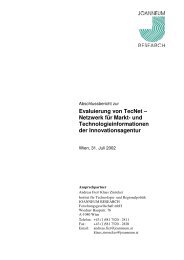23.11.2011 Ausgabe 36 - fteval
23.11.2011 Ausgabe 36 - fteval
23.11.2011 Ausgabe 36 - fteval
Sie wollen auch ein ePaper? Erhöhen Sie die Reichweite Ihrer Titel.
YUMPU macht aus Druck-PDFs automatisch weboptimierte ePaper, die Google liebt.
Introduction<br />
Alexander Kesselring<br />
Citizen participation in S&t planning –<br />
Process evaluation of the project CIVIStI (fP7)<br />
CIVISTI, a FP7 project 1 , aimed to identify new emerging issues for European Science and Technology by uncovering<br />
European citizens’ visions of the future and transform these into relevant recommendations for long term strategic<br />
planning of European S&T policies and funding programmes, in particular FP8. The consortium consisted of partners<br />
from 7 countries – Austria, Belgium, Bulgaria, Denmark, Finland, Hungary and Malta. Citizen consultations (CC) were<br />
organised in all these countries and coordinated by the Danish Board of Technology.<br />
The Centre for Social Innovation (Zentrum für Soziale Innovation, ZSI) worked as an independent subcontractor for the<br />
project consortium and was responsible for conducting a process evaluation with the following aims: To ensure the<br />
scientific quality of the project and to provide the project consortium as well as the EU commission with detailed information<br />
and assessments on deliverables and the process (organisation, methods, participant selection, participants’<br />
perception etc.).<br />
The evaluation should accompany the main steps of the CIVISTI process. We used a combination of qualitative and<br />
quantitative methods to ensure analytical specificity and depth in describing the process as well as broad coverage of<br />
participants’ perceptions and assessments. This approach comprised the analysis of available deliverables (in particular<br />
the analytical model) and information materials, a questionnaire survey for the first 2 (CC1) and the second round of<br />
citizen consultations (CC2), participant observations of CC1, CC2 3 and the expert stakeholder workshop and in addition<br />
two expert interviews conducted after the workshop. Figure 1 shows the consultation process and below the applied<br />
evaluation methods.<br />
1 Full evaluation report and comprehensive project documentation are available from www.civisti.org<br />
2 Due to the late introduction of an independent evaluation to the project (citizen consultations had already begun before the evaluation was<br />
sub-contracted to ZSI) we could only collect data from citizen consultations in Austria and Bulgaria for the first round. In the second round<br />
all countries were covered.<br />
3 Observation of CC1 in Austria and Bulgaria; observation of CC2 in Austria and Malta<br />
33<br />
Nr. <strong>36</strong><br />
06/2011<br />
Figure 1<br />
The main steps of the CIVISTI process and the corresponding evaluation methodology<br />
Source: CIVISTI deliverable D4.1 Analytical Model, page 9<br />
Note: CC abbr. Citizen Consultation, EXP abbr. Expert workshop<br />
The challenge of CIVISTI was to start with a very open focus – the future of Europe in the year 2030-40 – and finally to<br />
arrive at a set of S&T recommendations validated by experts and citizens which should be directed into the planning<br />
process of FP8. The process consisted of three main steps: A citizen consultation for developing visions (CC1) where<br />
no experts were present, an expert-stakeholder workshop where recommendations should be developed on basis of<br />
these visions and finally a second citizen consultation where citizens had to validate the expert recommendations<br />
(CC2). In the following I will try to highlight some unique characteristics of CIVISTI as a model for citizen participation in<br />
combination with our reflexions and assessments. The description will mainly rely on our observation protocols which<br />
turned out to be the most useful source of process information for us – witnessing the organisational and participative<br />
process was crucial for our understanding of the method and the implementation process and revealed very specific<br />
aspects of the CIVISTI approach. The questionnaire surveys were more important to provide the organisers with feedback<br />
and were only used here to provide some “snapshots” of citizens’ perceptions and assessments as well as basic<br />
demographic information.<br />
Selection process and participant characteristics<br />
At the beginning potential participants in 7 countries were identified through a recruitment procedure that was based<br />
on a simple quota plan comprising such demographic characteristics as gender, age, highest educational attainment<br />
and employment status. In CC1 164 citizens were participating with 21 to 25 participants per country. The aim was<br />
to achieve a balanced population sample, which was generally successful regarding gender, educational attainment<br />
and labour market status in the first round, albeit sample composition varied along the main characteristics across<br />
countries. The most likely selection bias seemed to be connected with educational attainment, a tendency that became<br />
more visible in the second round due to participant attrition (mean attrition was 47 % between CC1 and CC2) where<br />
participants with tertiary education were clearly overrepresented.<br />
34<br />
Nr. <strong>36</strong><br />
06/2011


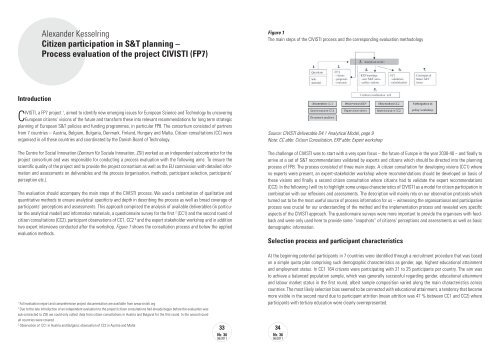

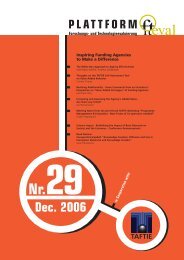
![roadMAP [PDF, 1.9 MB] - fteval](https://img.yumpu.com/21079876/1/184x260/roadmap-pdf-19-mb-fteval.jpg?quality=85)
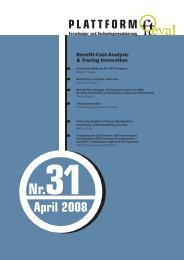
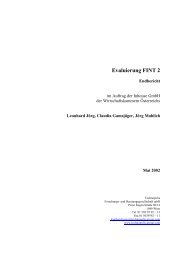
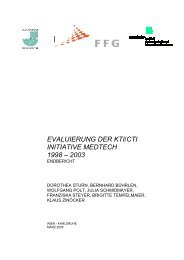
![GuggenbergeronBoku [PDF, 73.4 KB] - fteval](https://img.yumpu.com/21024081/1/184x260/guggenbergeronboku-pdf-734-kb-fteval.jpg?quality=85)
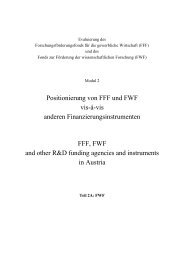

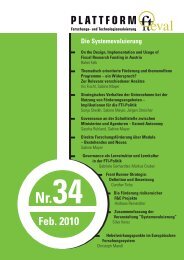
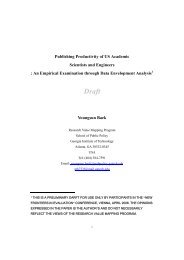
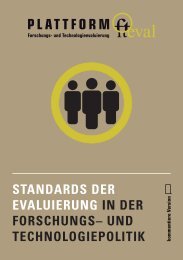
![ITF_Energietechnik [PDF, 39.6 KB] - fteval](https://img.yumpu.com/20959076/1/184x260/itf-energietechnik-pdf-396-kb-fteval.jpg?quality=85)
![Evaluation Standards [PDF, 120.8 KB] - fteval](https://img.yumpu.com/20931509/1/184x260/evaluation-standards-pdf-1208-kb-fteval.jpg?quality=85)
